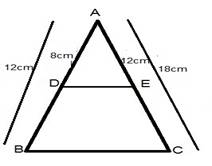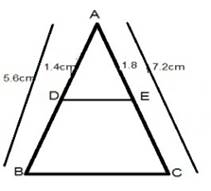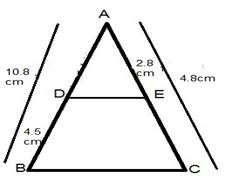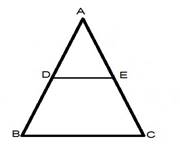In a![]() , D and E are points on the sides AB and AC respectively. For each of the following cases show that
, D and E are points on the sides AB and AC respectively. For each of the following cases show that ![]() :
:
(i) AB = 12 cm, AD = 8 cm, AE = 12 cm and AC = 18 cm.
(ii) AB = 5.6 cm, AD = 1.4 cm, AE = 7.2 cm and AC = 1.8 cm.
(iii) AB = 10.8 cm, BD = 4.5 cm, AC = 4.8 cm and AE = 2.8 cm.
(iv) AD = 5.7 cm, BD = 9.5 cm, AE = 3.3 cm and EC = 5.5 cm.

(i) AB = 12 cm, AD = 8 cm, and AC = 18 cm.
∴ DB=AB-AD
= 12-8
=4 cm
EC=AC-AE
= 18-12
= 6 cm
Now AD/DB=8/4=2
AE/EC=12/6=2
Thus DE divides side AB and AC of ⊿ ABC in same ratio
Then by the converse of basic proportionality theorem.
(ii)

AB = 5.6 cm, AD = 1.4 cm, AE = 1.8 cm and AC = 7.2 cm
∴ DB=AB-AD
DB=5.6-1.4
DB= 4.2 cm
And EC=AC-AE
EC= 7.2-1.8
EC=5.4
Now AD/DB=1.4/4.2=1/3
AE/EC=1.8/5.4=1/3
Thus DE divides side AB and AC of ⊿ ABC in same ratio
Then by the converse of basic proportionality theorem.
(iii)

we have
AB = 10.8 cm, BD = 4.5 cm, AC = 4.8 cm and AE = 2.8 cm
∴ AD=AB-DB
AD=10.8-4.5
AD= 6.3 cm
And EC=AC-AE
EC= 4.8-2.8
EC=2 cm
Now AD/DB=6.3/4.5=7/5
AE/EC=2.8/2=28/20=7/5
Thus DE divides side AB and AC of ⊿ ABC in same ratio
Then by the converse of basic proportionality theorem.
(iv)

DE∥BC
We have,
AD = 5.7 cm, BD = 9.5 cm, AE = 3.3 cm and EC = 5.5 cm
Now AD/DB=5.7/9.5=57/95 =3/5
AE/EC=3.3/5.5=33/55=3/5
Thus DE divides side AB and AC of ⊿ ABC in same ratio
Then by the converse of basic proportionality theorem.